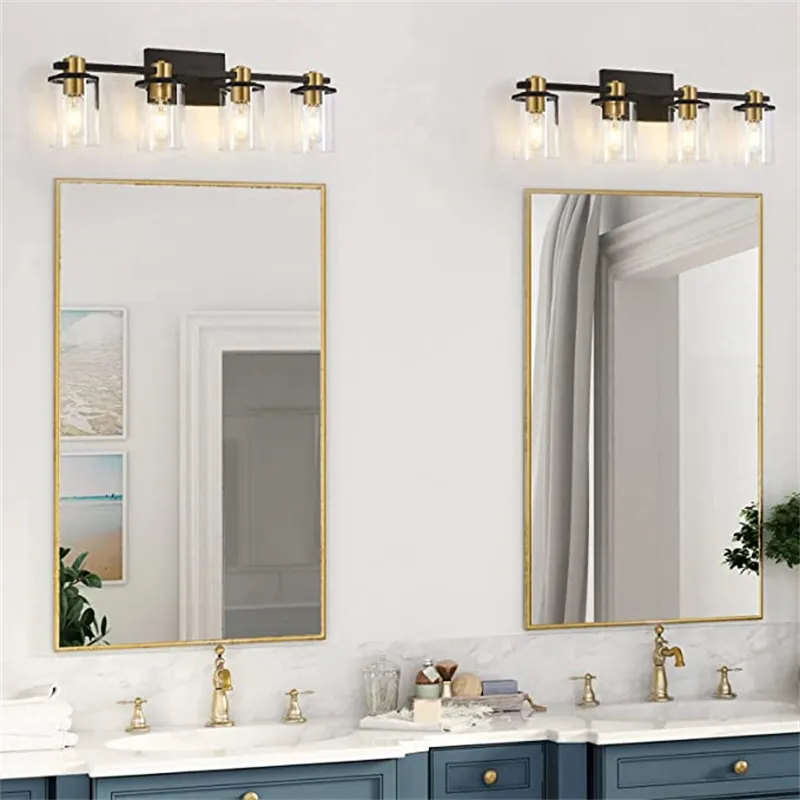LED Vanity Light Fixtures: What is the Color Rendering Index (CRI)?
In modern home design, LED vanity light fixtures have become indispensable lighting devices. Whether for makeup, skincare, or grooming, the light quality of a vanity lamp directly impacts the convenience and comfort of daily life.
Among the many lighting parameters, the "Color Rendering Index" (CRI) is one of the important indicators for measuring the light quality of LED vanity light fixtures.
This article will analyze in detail the importance of the CRI in daily use, covering its definition, concept, testing methods, practical impact, and purchasing guidelines.

LED Vanity Light Fixtures: What is an LED?
LED vanity light fixtures refer to lamps that use light-emitting diodes (LEDs) as the light source and are specifically installed on dressing tables or vanity surfaces to illuminate the face and surrounding environment.
Compared to traditional incandescent bulbs and energy-saving lamps, LED vanity light fixtures have the following characteristics:
• High Energy Efficiency: LED light sources consume less energy and have high luminous flux per watt, resulting in significant energy savings.
• Long lifespan: LED vanity light fixtures typically have a lifespan of 20,000 to 50,000 hours, far exceeding that of traditional lighting fixtures.
• Adjustable color temperature: Some LED vanity light fixtures support color temperature adjustment, simulating natural light, warm light, or cool light environments.
• High color rendering index: LED light sources provide a high color rendering index, ensuring accurate and true colors when applying makeup and observing the face.
Among these characteristics, the "color rendering index" directly determines the user experience of LED vanity light fixtures in beauty, makeup, and daily grooming, which is precisely the core value of the color rendering index.
LED: What is the color rendering index?
The color rendering index (CRI) is an optical indicator proposed by the International Commission on Illumination (CIE) to measure the accuracy with which a light source reproduces the colors of objects. It is expressed as a percentage; the higher the value, the more accurate the color reproduction of the light source.
• Value range: The color rendering index generally ranges from 0 to 100, with 100 representing complete color reproduction by the light source, similar to natural light.
• Importance: When applying makeup, applying skincare products, or observing delicate facial features, high color rendering index (CRI) LED vanity light fixtures allow users to see the true colors of objects, avoiding makeup mistakes or skin tone discrepancies.
• Applications: CRI is not only used in vanity lamps but also widely applied in photographic lighting, exhibition lighting, shop lighting, and other applications requiring accurate color reproduction.
It's important to note that a high CRI does not necessarily mean high luminance; these are different concepts. The luminance of LED vanity light fixtures is typically expressed in lumens (lm) or lux, while the CRI focuses on color reproduction capability.

How is the CRI measured?
The CRI of LED vanity light fixtures is primarily measured using the standard spectral comparison method. The specific procedure is as follows:
• Select a standard light source: Use a reference light source with a similar color temperature as the standard, such as daylight or incandescent light.
• Select test color samples: Typically, a set of standard color samples is used, including multiple colors such as red, yellow, green, and blue.
• Illumination Measurement: The color sample is illuminated by the tested LED vanity light fixtures, and the chromaticity data of the reflected light is measured.
• CRI Value Calculation: The color rendering index (CRI) is calculated by comparing the color rendering effect of the light source on the color sample with that of a standard light source.
It is worth noting that the CRI value is divided into Ra and specific color rendering indices. Ra is the average color rendering index, used to represent the overall color reproduction capability; while the specific color rendering index evaluates specific colors such as red and green, which is particularly important in makeup light design because skin tone is mainly composed of red and yellow.
LED Vanity Light Fixtures: The Impact of Color Rendering Index on User Experience
1. Makeup Accuracy
During the makeup process, the accurate representation of skin tone, blush, lipstick, and eyeshadow colors is crucial. LED vanity light fixtures with a low CRI may cause color deviations, for example, red lipstick may appear darker or lighter than its actual color, affecting the makeup effect.
2. Skincare Judgment
The high color rendering index (CRI) of LED vanity light fixtures more realistically reveals skin imperfections, dark spots, and fine lines, helping users accurately assess their skin condition and choose suitable skincare products.
3. Lighting Comfort
High CRI LED light sources typically have a balanced wavelength distribution, causing less eye strain and preventing noticeable fatigue even after prolonged use.
4. Natural Visual Experience
LED vanity light fixtures have a high CRI, with color reproduction close to natural light, resulting in a more natural overall visual experience. They avoid color deviations that appear bluish or yellowish, enhancing the comfort of the grooming environment.

LED: What is the Relationship Between CRI and Color Temperature?
LED vanity light fixtures not only focus on the CRI but also frequently consider color temperature (K). Color temperature determines the color bias of the light source and is an important indicator of whether it is warm white light, natural white light, or cool white light.
• Low color temperature (2700K-3000K): Warm light, appearing yellow or orange, suitable for soft environments, but may slightly affect the true representation of skin tone.
• Medium color temperature (4000K-4500K): Natural white light, suitable for everyday makeup, with good color rendering.
• High color temperature (5000K-6500K): Cool white light, simulating sunlight, suitable for detailed makeup and skin observation; a high color rendering index (CRI) allows for more accurate color reproduction.
Therefore, when choosing LED vanity light fixtures, both the CRI and color temperature should be considered. A high CRI combined with a suitable color temperature provides the most natural and accurate lighting environment.
LED Vanity Light Fixtures CRI Standards and Grades
According to international standards, the CRI of LED light sources can be divided into different grades:
Color Rendering Index (CRI) | Level Description | Usage Recommendations |
Below 80 | Average | Suitable for basic lighting, not recommended for vanity tables |
| 80-90 | Good | Suitable for home vanities; provides relatively accurate color reproduction |
| Above 90 | Excellent | Prioritized for professional makeup, skincare, and close observation; accurately reflects facial colors |
From a practical perspective, the CRI of LED vanity light fixtures should be at least 80. For professional makeup effects, it is recommended to choose fixtures with a CRI of 90 or higher.
LED Vanity Light Fixtures Color Rendering Index (CRI): Purchase Considerations
When purchasing LED vanity light fixtures, the color rendering index (CRI) is an important reference indicator, but not the only criterion. Here are some purchasing suggestions:
• Check the CRI label: Before purchasing, pay attention to the CRI value on the packaging or instruction manual to ensure the light source's CRI is within an acceptable range.
• Pay attention to spectral balance: In addition to the CRI value, high-quality LED vanity light fixtures usually have a continuous and balanced spectral output, avoiding color casts or shadows.
• Combine color temperature selection: When purchasing, consider both color temperature and CRI. A high CRI value combined with a color temperature of 4000K-5000K is best for makeup application and facial observation.
• Light uniformity: Even with a high CRI, uneven light distribution can affect the makeup application experience. Choosing LED vanity light fixtures with adjustable dimming and uniform illumination is particularly important.
• Anti-glare design: A high CRI does not mean soft light; excessively strong light may cause glare. Choosing LED vanity light fixtures with anti-glare or diffused shades can protect your eyes and improve user comfort.
Market Level: What is the Color Rendering Index (CRI) of LED vanity light fixtures?
Currently, most household LED vanity light fixtures on the market have a CRI between 80 and 90, which is sufficient for daily makeup and facial care needs. High-end professional LED vanity light fixtures can achieve a CRI of over 95, presenting facial colors close to natural light. These fixtures are suitable for users seeking the ultimate makeup effect, especially important in color-sensitive applications.

How many bulbs are typically in a vanity lamp?
Common Number of Bulbs in Vanity Lamps
1. Traditional Vanity Bar Lights
These lamps are usually fixed above or to the sides of the mirror.
Common vanity lamps have 3, 4, or even more bulbs. For example, you might see designs like "3 Bulb Vanity Light".
According to Huari Lighting's sizing guidelines, if the mirror or countertop is wide, using multiple bulbs can provide more even lighting.
For example, 4-bulb vanity light fixtures are an example of four lights.
2. Integrated Backlit or Edge-lit Mirrors
Some vanity mirrors are integrated LEDs (backlit mirrors/edge-lit mirrors). These don't use the concept of "bulbs," but rather LED strips or panels.
This type is usually described not with "number of lights," but rather with the length of the light strip, brightness (lumens), color rendering index, etc.
Who is Huari Lighting and what do you manufacture?
Huari Lighting Co., Ltd. is a China-based LED lighting manufacturer founded in 1996 with a full-production factory footprint. We operate on a 92,000 square meter site and run professional assembly lines capable of producing over one million lighting units and accessories per month.
As a supplier for global retailers and trade buyers, we design and supply a wide range of LED products — from motion-sensor night lights and silicone bedside lamps to multifunctional night lights, vanity wall lamps, downlights, panel lights, track lights and cabinet lighting.
